We use affiliate links to run our site. When you buy through links on our site, we may earn an affiliate commission, without any added cost to you. Learn more
There’s truly nothing as enchanting as the sight of a dolphin in the wild. Its playful nature and ability to jump high out of the water are enough to mesmerize anyone. But did you know that there are different types of dolphins thriving in today’s oceans?
Dolphins belong to a group of marine mammals called cetaceans, along with whales and porpoises. There are actually over 40 different species of dolphins that live in oceans and rivers around the globe. That’s right – the world of dolphins is vast and exciting.
In this blog post, we’ll take a dive into the watery world of dolphins and explore some of the most fascinating dolphin species out there.
Here is a list of the most popular dolphin species in this world and their distinguishing features.
| Dolphin Species | Distinguishing Traits |
|---|---|
| Common Bottlenose Dolphin | – Found worldwide in tropical oceans and warm waters. – Large size: 10-14 feet, over 1,000 pounds. – Known for intelligence and echolocation abilities. |
| Dusky Dolphin | – Known for acrobatic jumps and dives. – Found in coastal waters in the Southern Hemisphere. – Smaller size: about 6 feet, around 200 pounds. |
| Hourglass Dolphin | – Cold-water dolphin with distinctive hourglass-shaped markings on sides. – Short and stocky: about 6 feet, 200 pounds. – Known for “bow riding.” |
| Orca (Killer Whale) | – Largest dolphin species, found in all oceans. – Male orcas can reach 20-26 feet and weigh 3-4 tons. – Complex social bonds and matriarchal pods. |
| Atlantic Spotted Dolphin | – Found in tropical parts of the Atlantic Ocean. – Develop small black spots on the body. – Medium-sized: around 7.5 feet, roughly 300 pounds. |
| Irrawaddy Dolphin | – Can live in both salt and fresh water. – Resembles the Australian snubfin dolphin. – Shy, introverted, and endangered species. |
| Hector’s Dolphin | – Smallest and rarest marine dolphins, found near New Zealand. – Rounded dorsal fin resembling Mickey Mouse’s ear. – Population increase in recent years. |
| Commerson’s Dolphin | – Oceanic dolphin with a distinctive black and white color pattern. – Small size: under 5 feet, 50-75 pounds. – Social with other dolphin species. |
| Long-finned Pilot Whale | – Second-largest dolphin species after Orca. – Long pectoral fins and cold-water preference. – Highly social and accepts various species into pods. |
| Peale’s Dolphin | – Small dolphins found around the southern cone of South America. – Mix of dark gray and black with a bow-shaped dorsal fin. – Historical vulnerability to fishing. |
| Spinner Dolphin | – Small dolphin found in tropical waters known for acrobatic spinning. – Long and thin: about 6 feet, under 100 pounds. – Social and spinner behavior purpose not entirely understood. |
| False Killer Whale | – Resembles Orcas but distinguished by dark gray coloring. – Large pods and social nature. – Occasional mass beaching events due to social behavior. |
| Striped Dolphin | – Widespread and commonly studied dolphin with characteristic black stripes around eyes and body. – Fast swimmers often hunted in Japan for their meat. |
| Clymene Dolphin | – Small oceanic dolphin found only in the Atlantic Ocean. – Hybrid species between spinner and striped dolphins. – Known for acrobatics due to spinner ancestry. |
| Southern Right Whale Dolphin | – Unique appearance with no dorsal fin and two-tone black and white coloration. – Found in cold waters of the Southern Hemisphere. – Foraging behaviors not well-documented. |
| Rough-Toothed Dolphin | – Distinctive appearance with ridged teeth and reptilian-like features. – Favor warm and tropical waters across the equator. – Highly communicative and social in small pods. |
| Indo-Pacific Humpback Dolphin | – Rare species living in coastal waters around China and Taiwan. – Subspecies exhibit different colors (white and pink). – Some subspecies are highly endangered. |
| Long-Beaked Common Dolphin | – One of the most populous dolphin species, found in oceans globally. – A long beak makes up 10% of its body size. – Long Beaked and Short Beaked Common Dolphins are now considered part of the same species. |
| Electra Dolphin | – Also known as the Melon-Headed Whale, it prefers subtropical oceanic waters. – Canonical heads and torpedo-shaped bodies. – Highly social with matriarchal pods. |
Common Bottlenose Dolphin
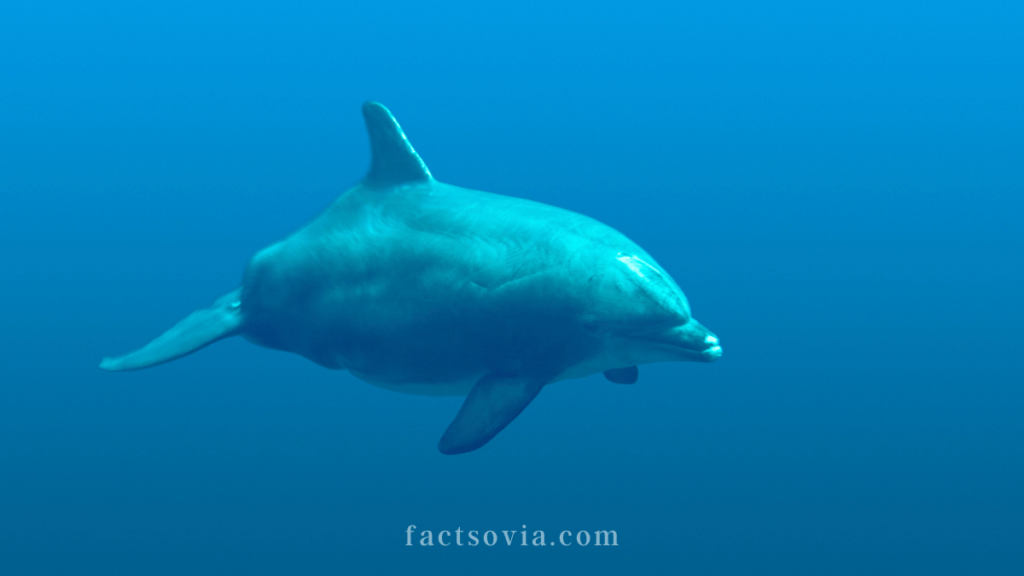
One of the most well-known dolphin species is the common bottlenose dolphin. These intelligent and charismatic dolphins live in warm temperate and tropical oceans around the world. Bottlenose dolphins have short, stocky bodies and can reach 10-14 feet in length and weigh over 1,000 pounds.
Bottlenose dolphins are famous for their intelligence. Their large brains allow them to have advanced communication skills, problem-solving abilities, self-awareness, and even distinct personalities! Bottlenose dolphins use echolocation to find prey, navigate their surroundings, and communicate with each other by making clicking sounds.
These highly social dolphins live together in pods that usually contain 10-30 members. Bonding and cooperation are very important in bottlenose dolphin pods. Dolphins protect sick or injured pod mates at the surface so they can breathe. Mother dolphins even help each other out by babysitting calves.
Dusky Dolphin
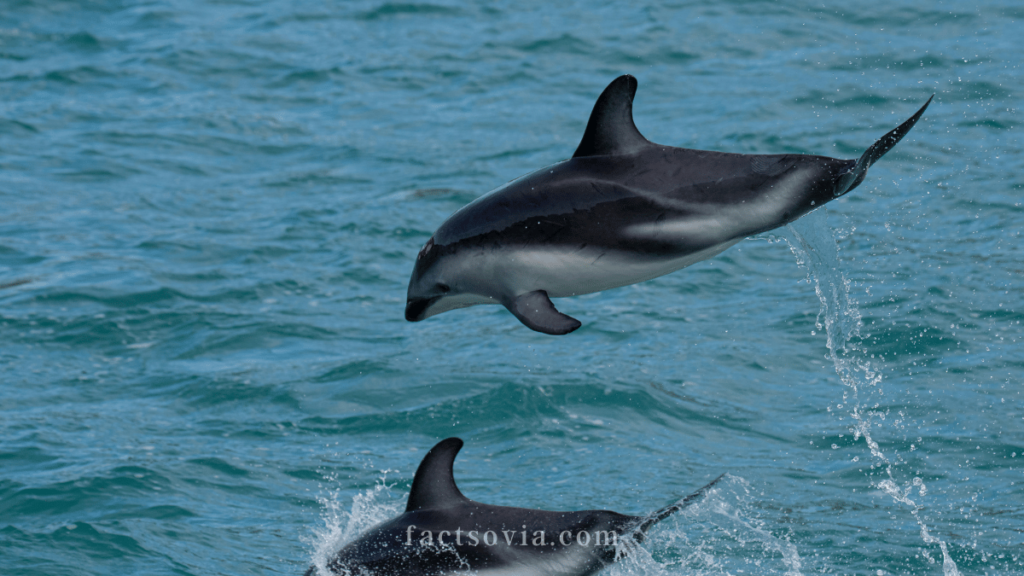
Dusky dolphins are found in coastal waters of South America, New Zealand, Australia, and South Africa. They get their name from their dusky gray coloring on the back and sides. Dusky dolphins have a slim, streamlined body that grows to about 6 feet long and 200 pounds.
Known for their acrobatics, dusky dolphins often leap high into the air and spin as they dive back beneath the surface. They are also incredibly fast swimmers, reaching speeds over 20 miles per hour. Dusky dolphins hunt for fish and squid either individually or cooperatively in groups.
These energetic dolphins travel in large pods of 100-1000 members. Pods join and split frequently as they migrate long distances along coastlines. Dusky dolphins are very playful and social. They communicate using physical displays like fin slapping, leaping, and tail slapping.
Hourglass Dolphin
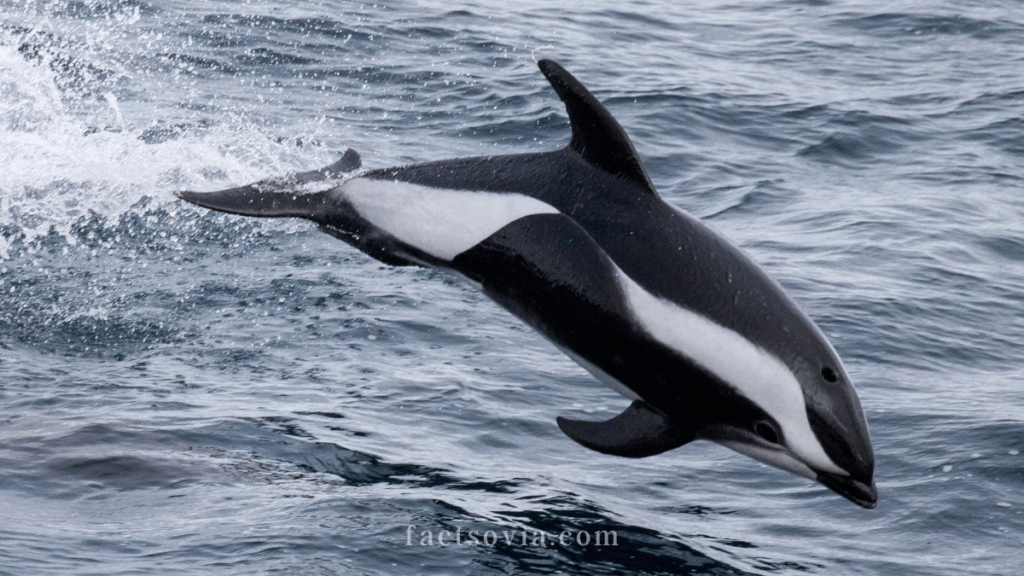
The hourglass dolphin lives in the cold waters around Antarctica, Argentina, Chile, and various islands in the Southern Ocean. It gets its name from the unique crisscrossing or hourglass-shaped markings on its sides.
Hourglass dolphins have short, stocky bodies that grow to about 6 feet long and 200 pounds. Their flippers are wide and paddle-shaped, while the dorsal fin is tall and triangular. The hourglass dolphin’s coloration is dark gray on top which fades to white underneath.
This cold water species has a thick layer of blubber to insulate it from frigid temperatures near Antarctica. Hourglass dolphins often ride the bow wake in front of ships. They feed on squid, fish, and crustaceans.
Hourglass dolphins live in packs that can contain hundreds of individuals. They are very active and social. Their acrobatic leaps and tail slaps communicate within the pack.
Orca (Killer Whale)
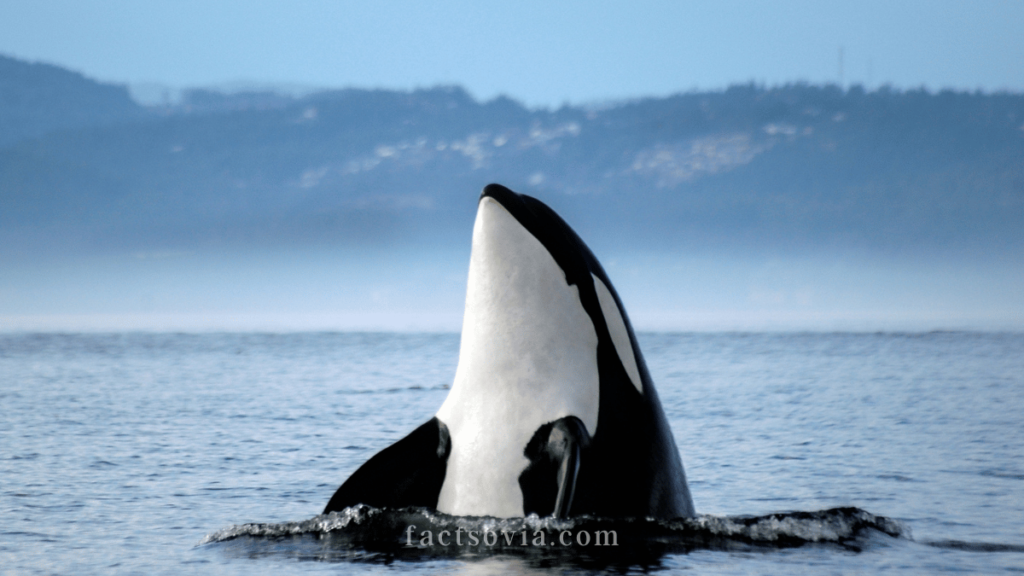
Orcas, also known as killer whales, are actually the largest members of the dolphin family! They live in all the world’s oceans from tropical to freezing polar seas.
Male orcas typically range from 20-26 feet long and weigh a massive 4-8 tons. Females are smaller at 16-23 feet and 3-4 tons. Orcas have striking black and white coloring and a tall, triangular dorsal fin up to 6 feet high in males.
Orcas live in tight-knit social groups called pods. Each pod contains 5-30 related members led by a matriarch. Pods work together to hunt prey like seals, fish, squid, and even large whales. Their hunting strategies demonstrate advanced communication and cooperation.
One of the most complex social species, orcas have their own cultures and dialects. Each pod has distinctive vocalizations and behaviors that are taught to younger generations. Some orca pods focus on hunting fish, while others specialize in hunting marine mammals.
Atlantic Spotted Dolphin
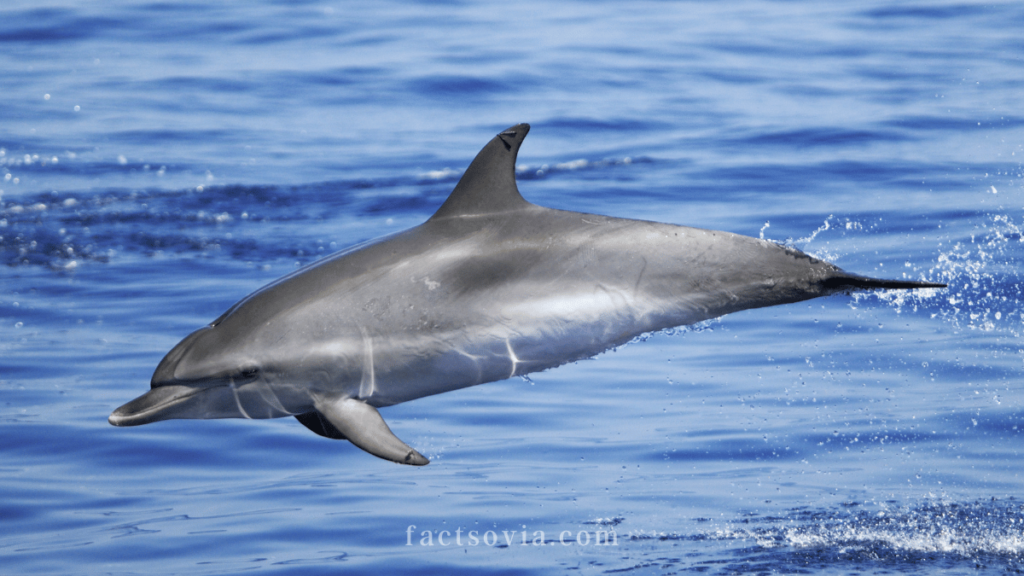
As the name suggests, Atlantic spotted dolphins live in tropical and warm temperate parts of the Atlantic Ocean. They are characterized by the spots that develop on their body as they mature. The spots are black or dark gray and increase in number and size as the dolphin ages.
Atlantic spotted dolphins have thin, graceful bodies that grow to about 7.5 feet long and 300 pounds. Their beak is narrow and they have a curved dorsal fin. These dolphins are grey on top and light gray to white on the underside.
Found in shallow coastal waters and offshore, Atlantic spotted dolphins feed on a variety of fish and squid species. They are fast, energetic hunters that also perform acrobatics like somersaults and spins. Atlantic spotted dolphins gather in large groups of 100-500 individuals for protection.
Irrawaddy Dolphin
The Irrawaddy dolphin, or Orcaella, inhabits coastal regions of Southeast Asia and Australia. This species is named after the Irrawaddy River in Myanmar where it was first discovered. The Irrawaddy dolphin’s most distinctive feature is its bulging forehead that tapers into a short beak.
Reaching lengths of 7-8 feet, the Irrawaddy dolphin has a sturdy body shaped like a beluga whale. Its color pattern is unique—the dorsal side is slate blue to gray while the ventral side is white with a pink tint. This helps camouflage them from above and below.
Irrawaddy dolphins inhabit both saltwater and freshwater environments like rivers, estuaries, and mangroves. They feed on fish, crustaceans, and cephalopods. These dolphins are shy and introverted compared to most species. They live in small family groups of 6-8 members.
Sadly, Irrawaddy dolphin populations are endangered due to habitat degradation, fishing, and pollution. There are estimated to be less than 6,000 left in the wild.
Hector’s Dolphin
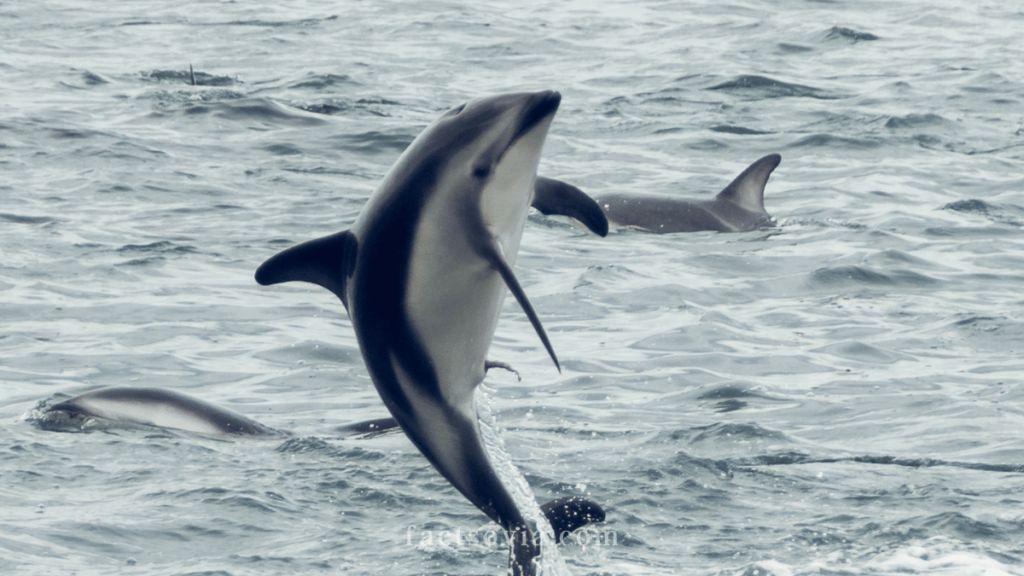
Native to the coastal waters of New Zealand, Hector’s dolphin is one of the smallest and rarest marine dolphins in the world. Adults grow to just 4-5 feet long and weigh up to 100 pounds.
The most recognizable feature of Hector’s dolphin is its distinctive rounded dorsal fin. The shape resembles Mickey Mouse’s ear! These dolphins have a black rounded dorsal fin, gray patches around the eyes, and all-gray coloring.
Hector’s dolphins live in small social groups of between 2 and 8 individuals. They feed on small fish and squid, hovering vertically in the water column to hunt. Their populations were once endangered but have rebounded in recent years.
There are currently around 7,000-9,000 Hector’s dolphins left in the wild. Ongoing conservation efforts focus on protecting them from becoming entangled in fishing nets.
Commerson’s Dolphin
Commerson’s dolphin, also known as the skunk dolphin or piebald dolphin due to its black and white coloring. It is named after French naturalist Philibert Commerson and is one of the most distinctive-looking dolphin species.
Native to the cold coastal waters of South America and islands in the Southern Ocean, the Commerson’s dolphin grows to about 4-5 feet long and 50-125 pounds. The body patterns feature black on the head, dorsal fin, flippers, and fluke while the rest of the body is white.
The Commerson’s dolphin feeds on small fish, squid, and crustaceans. Its speed and agility allow it to catch fast-moving prey. These dolphins live in small family groups of around 3-10 individuals. They also associate with other dolphin species like the Chilean dolphin.
Long-finned Pilot Whale
Despite their name, long-finned pilot whales are actually the second largest species of dolphin behind orcas. Adult males reach lengths of 20 feet and weigh up to 6 tons. They are found in cold temperate oceans worldwide, though mainly in the Southern Hemisphere.
As the name suggests, long-finned pilot whales have exceptionally long pectoral fins that can measure up to 16 inches. They have a bulbous head with a thinly hooked dorsal fin. The coloring is all black or dark gray with light anchor-shaped patches on the belly.
Long-finned pilot whales live in close-knit social groups of 10-30 members called pods. Multiple pods will temporarily gather to form larger groups of 100 or more. Pilot whales vocalize with whistles and clicks to communicate and hunt squid at great depths.
An interesting fact about pilot whales is that they allow other species like bottlenose dolphins to join their pods. This shows their highly social and accepting nature.
Peale’s Dolphin
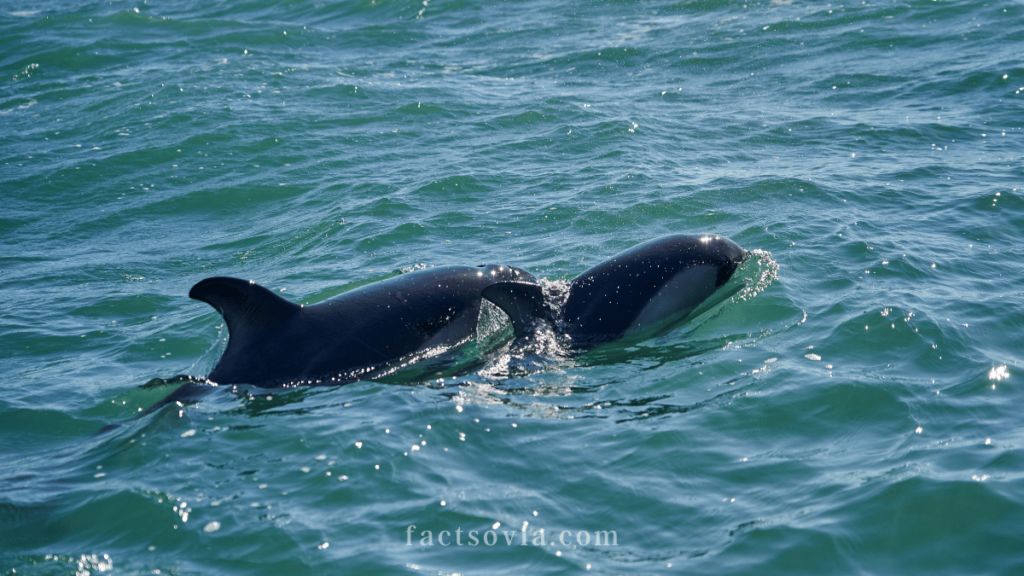
Peale’s dolphin lives in the coastal waters of southern South America including the Straits of Magellan, the Falkland Islands, and even down to Antarctica. It was named after the American painter Titian Peale.
A small species, Peale’s dolphin reaches lengths of 5 feet and weighs up to 150 pounds. It has a robust body with a short beak. The coloring is unique—the back is dark gray that fades to light gray on the flanks and black margins on the fins.
These dolphins feed on fish, squid, and crustaceans. They live in small pods of 2 to 15 members that swim together loosely. Peale’s dolphin was heavily hunted for crab bait in the early 20th century, leading to population declines. Conservation efforts now aim to protect the species.
Spinner Dolphin
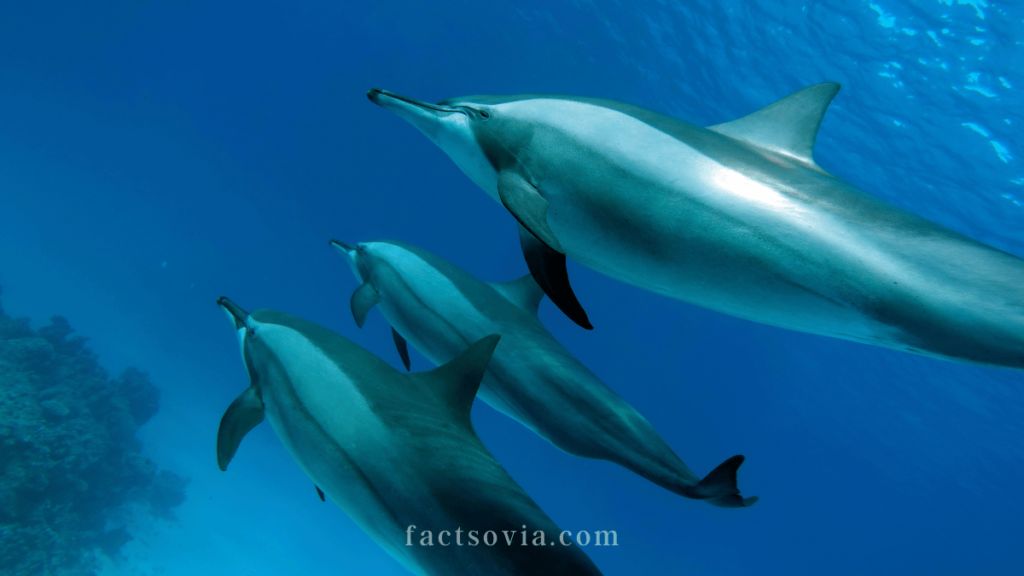
Known for their aerial displays, spinner dolphins are found in tropical and subtropical waters around the world. They get their name from their spinning behavior—they make up to 7 consecutive spins as they leap out of the water.
Spinner dolphins have elongated, thin bodies that reach 6-7 feet long and under 175 pounds. Their beaks are thin and pointed and their dorsal fins are tall and curved. Coloring is dark gray on the back and sides, lightening to white on the belly.
These energetic dolphins travel together in huge schools of hundreds or even thousands of individuals. Within the schools are smaller cliques of 10-50 members. Spinner dolphins feed cooperatively on small fish and invertebrates.
The purpose of their spinning behavior when breaching is not fully understood. Possible explanations are communication, removing parasites, or just play.
False Killer Whale
As the name implies, the false killer whale shares many similarities with orcas in appearance, despite not being closely related. They have a similar large size, reaching lengths of 15-20 feet and weights of 1-4 tons.
However, false killer whales can be distinguished from orcas by their uniform dark gray color and more slender body shape. They have a tapered head without the white eye patch and gray saddle patch.
False killer whales are found in tropical and subtropical oceans worldwide, especially around island chains. They feed on fish and cephalopods at depths of around 1,000 feet. These large dolphins live in close-knit social groups of 20-100 members called pods.
One interesting behavior is occasional mass strandings that are thought to be a result of the pod’s strong social bonds. If one member strands or is in distress, the others follow to provide support.
Do Dolphins Lay Eggs? The Surprising Truth About Dolphin Reproduction
Striped Dolphin
One of the most recognizable and well-studied dolphins, the striped dolphin is named for the distinctive stripes and bands on its body. The dark stripes extend from the beak, around the eyes, and down the sides towards the tail. They also have a white tip on a dorsal fin.
Striped dolphins have streamlined bodies that reach 8 feet long and weigh up to 300 pounds. They are found widely in tropical and temperate oceans around the world. Striped dolphins often congregate in large groups of hundreds or thousands of individuals.
These fast-moving dolphins frequently ride waves at the front of boats. They also make high, powerful leaps above the water. Striped dolphins feed on small fish, squid, and crustaceans. Their tendency to gather in dense groups, unfortunately, leads them to be heavily hunted for their meat in places like Japan.
Clymene Dolphin
The Clymene dolphin is an oceanic dolphin that lives in tropical and subtropical waters of the Atlantic Ocean. Genetic studies show it is a hybrid species between the spinner dolphin and the striped dolphin. From the spinner dolphin, it gets its acrobatics and aerial behaviors.
Reaching about 7 feet and 200 pounds, the Clymene dolphin has a slender build and short beak similar to the spinner. However, it has the striped dolphin’s dark face marking through the eye and a tri-colored pattern on its sides. The back is dark brown, the sides are tan brown and the belly is white.
Clymene dolphins feed on small fish, squid, and crustaceans. They live in large groups of up to 100 members. Due to sparse observations, little is known about this species’ behaviors and population size.
How Long Do Dolphins Really Live?
Southern Right Whale Dolphin
The Southern right whale dolphin is a unique-looking species found in cool waters of the Southern Hemisphere. It gets its name from the fact that it lacks a dorsal fin, just like right whales. This gives it a graceful, arching shape.
Growing to about 9 feet long, the Southern right whale dolphin has a robust body with a small head and no beak. The coloring is striking—the back and sides are solid black while the belly is bright white. The contrast makes them appear two-toned.
These dolphins feed on small fish, squid, and krill. They swim in large groups but can be elusive and fast-moving, making their foraging behaviors difficult to observe. Population data for this species is also limited.
Southern right whale dolphins are extremely social and associate with several dolphin and whale species. Groups congregate around South American shorelines with seasonal migrations.
Rough-Toothed Dolphin
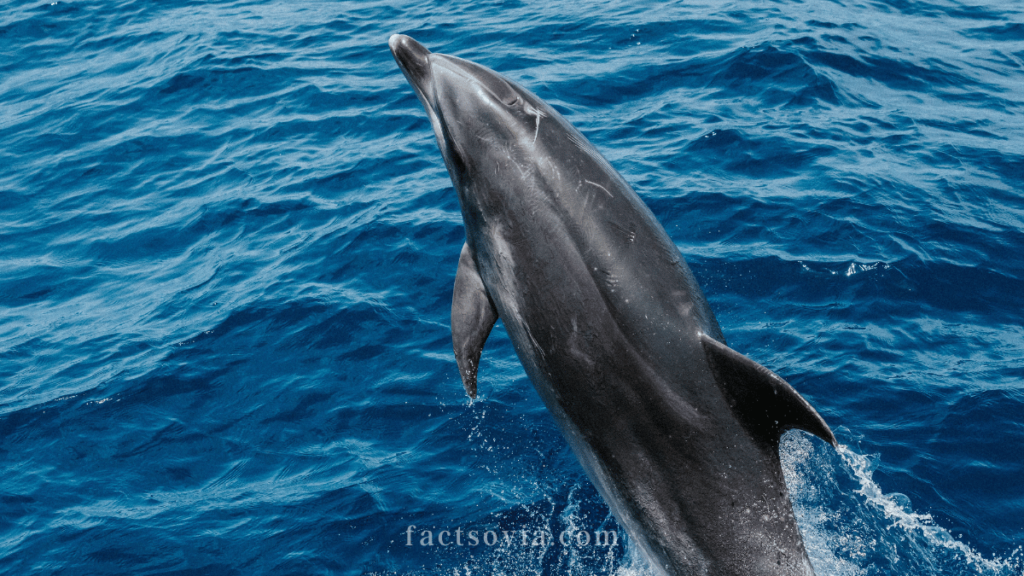
Just as the name suggests, rough-toothed dolphins have unique cone-shaped teeth that give them a reptilian appearance. They inhabit tropical and subtropical waters worldwide.
Reaching lengths of 6-8 feet, rough-toothed dolphins have robust, stocky bodies with a well-defined beak. Their dorsal fin is tall and curved and the flippers are small and pointed. The coloring is dark gray on the back and sides, fading to lighter gray on the belly.
Rough-toothed dolphins feed on fish and invertebrates in shallow coastal waters at night when prey rises closer to the surface. They live in compact social groups of 10-20 members.
These dolphins are highly communicative, using touch, vision, and echolocation to maintain group cohesion. They often approach human divers and rub against them.
Indo-Pacific Humpback Dolphin

The Indo-Pacific humpback dolphin lives in shallow coastal waters from southeastern Africa to Australia and as far north as China. It was only recognized as a distinct species in 2014. There are actually three subspecies with different color patterns.
The Indo-Pacific humpback dolphin has a stubby head with a steep forehead. The body length reaches around 8 feet and weighs 200 pounds. Some populations are white or pinkish, while others are more gray. They all share a narrow dorsal ridge rather than a fin.
This rare dolphin inhabits tropical estuaries, bays, and mangrove channels less than 100 feet deep. Some subspecies are endangered due to habitat loss, fishing, and pollution. However, number data across the range is not available due to their recent distinction.
Long-Beaked Common Dolphin
Despite their name, long-beaked common dolphins are now considered the same species as the short-beaked common dolphin. They live in all temperate and tropical oceans around the world in large groups.
As suggested by their name, long-beaked common dolphins have a long, thin beak that makes up 10% of their 8-foot-long body. Otherwise, their physical appearance matches the short-beaked variety—a slender body with a tall, sickle-shaped dorsal fin.
Long-beaked common dolphins feed on small fish, squid, and invertebrates. They often associate and hybridize with other dolphin species. It is estimated there are tens of millions of long and short-beaked common dolphins, making them one of the most abundant dolphins.
Electra Dolphin
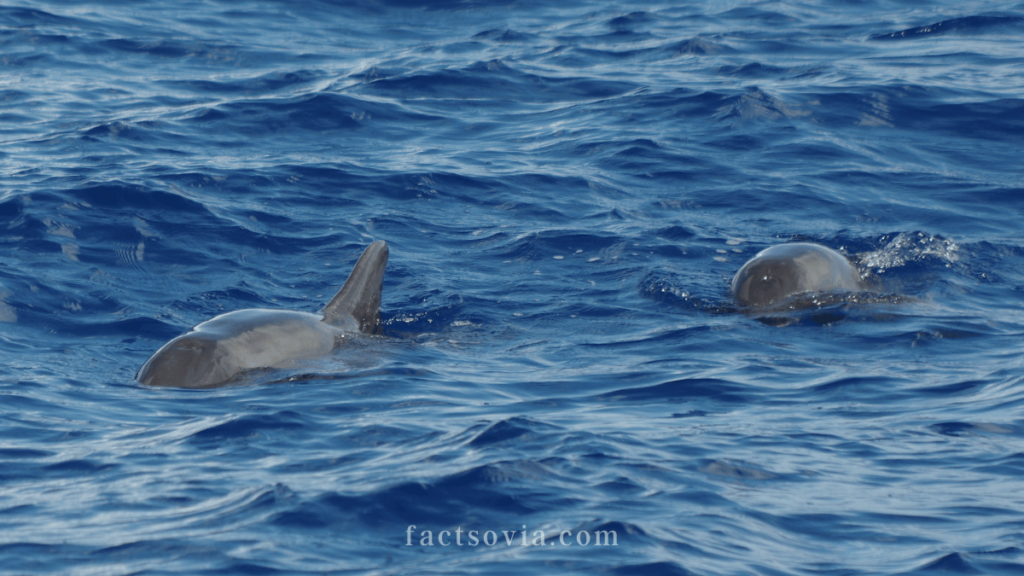
Also known as the melon-headed whale, the Electra dolphin lives in open waters of the subtropics and tropics worldwide. It gets its name from the distinct box-like shape of its head that resembles a melon.
Electra dolphins have torpedo-shaped bodies reaching 9 feet long and 500 pounds. They are uniformly dark gray all over and do not have a beak. Their dorsal fin is thick and wide-based. Melon-headed whales swim together in social groups of 100-500 led by females. They feed on fish, squid, and crustaceans over 1,000 feet deep.
Not much else is known about this species since they rarely approach boats and mainly live offshore. Their populations seem stable although some are killed as bycatch in tuna fisheries.
Dolphin Diversity
This gives you an overview of just some of the amazing dolphin species found across our oceans. From icy polar seas to tropical coral reefs, dolphins have adapted to nearly every marine environment. They also demonstrate incredibly complex social bonds, communication, and hunting abilities.
Despite centuries of interactions with humans, dolphins never cease to amaze us with their intelligence, playfulness, and unique underwater lifestyles. Each species has its own distinguishing traits and behaviors. Dolphins continue to be one of the most beloved marine animals worldwide.
With growing impacts on the oceans, dolphins also serve as an important indicator species reflecting the overall health of marine ecosystems. Protecting dolphins and their habitats ensures the conservation of countless other interconnected plants and animals. Discover more about dolphins near you and how you can get involved!
Final Thoughts:
Dolphins are a diverse group of animals with unique features, characters, and traits. Their intelligence, acrobatic-level athleticism, and beauty have made them a favorite among animal lovers. The types of dolphins that this blog post focused on were just a few of the numerous kinds of dolphins living in our oceans.
There are still many other dolphin types to discover, and innumerable things to learn and appreciate about their lifestyle, breeding, and habitats.
We hope this blog post has sparked a fascination in you and encouraged you to go out and learn more about these incredible creatures.
Amazon and the Amazon logo are trademarks of Amazon.com, Inc, or its affiliates.
